SOCIAL
How 13 news publishers are using WhatsApp Channels

More than two billion people worldwide use WhatsApp for messaging, customer service, organizing communities, and sharing news headlines. Now, increasingly, they can get those headlines straight from the source.
At the end of September, the Financial Times launched its first WhatsApp Channel, for global markets news. The Meta-owned WhatsApp describes Channels, launched in beta over the summer and rolled out globally in September, as “a one-way broadcast tool for admins to send text, photos, videos, stickers, and polls.” The FT’s global markets channel, which sends out one free story a day, grew quickly, and on October 9, the FT launched a second channel, dedicated to news of the Israel-Hamas conflict.
“It took a year for us to grow an audience of 35,000 on Telegram, first around the pandemic and then the war in Ukraine,” said Rachel Banning-Lover, the FT’s head of social media and development. “Comparatively, we [grew] a similar-sized following around markets on WhatsApp in two weeks.”
The FT is one of a growing number of news publishers testing WhatsApp Channels. “We know that the way people share news stories is changing. They’re not sharing stories on Facebook or Twitter as much as they used to; they’re texting them to their friends and their group chats,” said Nisha Chittal, Vox.com‘s managing editor. “We wanted to find a way to tap into that audience behavior.”
We talked to 13 publishers around the world about how they’re using Channels. They stressed it’s too soon to define an official Channels strategy, especially since WhatsApp doesn’t offer much in the way of metrics. “We can only see the approximate number of people who viewed a post, as well as the quantity of each type of emoji reaction they used,” noted Andrés Krom, chief editor of social media at Argentina’s La Nación.
Still, they shared some of what they’re seeing early on. Responses have been lightly edited for length and clarity.
Financial Times
Global markets news followers: 69,700
Israel-Hamas news followers: 24,300
Common emoji reactions (Israel-Hamas news): 🇵🇸 🇮🇱 🖕😢 👍
Rachel Banning-Lover, head of social media and development at the Financial Times:
Our strategy is based on learnings from two places: First, a previous Telegram channel we ran on the war in Ukraine, which we found most effective in the early days of the war, and second, a WhatsApp channel we launched for Markets grew very quickly in a short space of time, so we thought WhatsApp was the right place now to reach new audiences.
The FT’s social media team runs the channel. We pick a handful of the top stories from FT.com each day and run our choices by the world news desk before posting. Each post should give followers a general, brief overview of what’s happening. We try to pick out a mix of stories that cover the biggest developments, highlight original reporting, and that are already well-read on FT.com, so if you only read that update and no other news, you’re still well-informed.
I’m trying to find the balance between shortening our updates and providing enough context on each story in our Israel-Hamas news channel. What we’ve seen so far is that people are most likely to click through on the first story in any update. In our markets channel, we’ve been sending shorter messages, just promoting one story. The topic seems to be the biggest indicator of whether a story will do well in either channel.
Stories clearly marked as exclusives tend to get more reactions in the markets channel, and on both channels we’ve seen a spike in engagement with posts sent on a Friday. However, it’s important to note that we don’t typically post at the weekend, so the Friday posts get the longest run when new users discover the channel.
WhatsApp doesn’t provide any data on the people who have subscribed to our channel so we can’t see where they’re from, their gender or age bracket, so it’s hard to compare them to audiences for other channels. We can see the majority of people coming back to FT.com, though, are not subscribers — a shared experience across our channels.
Looking just at direct messaging apps, it seems easier to grow a following on WhatsApp than Telegram. It took a year for us to grow an audience of 35,000 on Telegram, first around the pandemic and then the war in Ukraine. Comparatively, we’ve grown a similar sized following around markets on WhatsApp in two weeks. I’d be really curious to know exactly who we’re reaching on WhatsApp — one of the interesting things we learned when experimenting with Telegram was that we were reaching people in countries we didn’t reach on other platforms.
It’s still not straightforward to set up a channel on WhatsApp — you’ve got to reach out to Meta to get access and it can take several days for them to verify your channel so it’s searchable.
It’s also worth thinking about how many updates to send out per day. When people first sign up to a channel, push notifications are muted so you want to motivate them to turn these on. I’ve seen some channels send out 10-plus updates a day on very unconnected topics — would you really want to get that many push notifications a day from a news organization?
La Nación (Argentina)
Channel followers: 392,500
Common emoji reactions: 👍 😂 ❤️ 🦁
Andrés Krom, chief editor of social media:
WhatsApp is a rather informal space where you chat in confidence with your best friend, mom, or partner. So, we set out to speak to our followers in a plain and friendly language, without depriving them of the quality content they are accustomed to. In my opinion, this platform represents a great opportunity to communicate in a more personal, intimate way with your followers and experiment with alternative (shorter!) methods of storytelling.
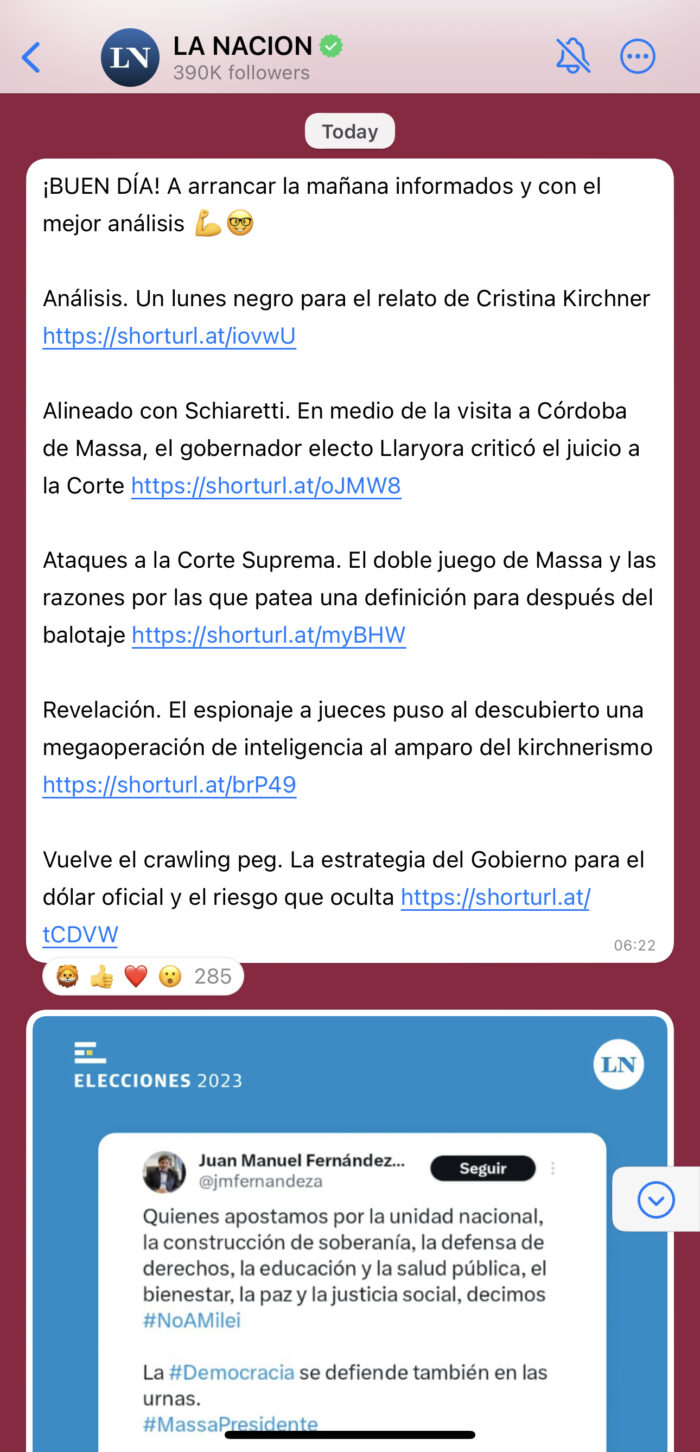
2023 seems to be a pivotal year for Argentinians — not only because we have seen some of the highest inflation rates in the world, but also because we are in the midst of a particularly contentious presidential election. Helping our audience navigate this sea of uncertainty is part of our mission, and for that, we must make use of all the technological means at our disposal.
In terms of metrics, WhatsApp channels are still somewhat rudimentary. We can only see the approximate number of people who viewed a post, as well as the quantity of each type of emoji reaction they used. Posts with more views or amount of emojis usually revolve around the dispute between presidential candidates Javier Milei, Patricia Bullrich, and Sergio Massa. I feel it’s too early to draw conclusions, but our WhatsApp audience certainly seems to show more interest in political content than in entertainment, crime, or [lifestyle] stories.
Since Meta deactivated Instant Articles in [April], the traffic generated by our social media posts dropped dramatically. Rather than seeing it as a tragedy, we viewed it as an opportunity. The challenge was to think how we would transform ourselves in this new post-traffic world. That’s why we decided to keep the number of links on our WhatsApp channel to a minimum.
We tend to prioritize shorter texts, perhaps one or two paragraphs, to convey the main points of a news story. The idea is that, in most cases, our followers can find out what happened without the need to leave the platform. We don’t shy away from links, but we reserve them for more in-depth news articles or columns.
The New York Times
Channel followers:
New York Times: 4,617,000
NYT Games: 1,132,800
NYT Cooking: 1,038,000
NYT Wirecutter: 472,300
Common emoji reactions: 😢 👍 😂 ❤️ 😮
Jake Grovum, head of off-platform:
Vindu Goel, our director of community engagement, had been looking for a way to make WhatsApp a viable audience driver for years, and the app’s Channels feature is something that we thought finally made that possible. Vindu was a driving force in making sure we were ready from day one, and contributed a lot to our strategy early on.
Alexa Díaz, a social editor on my team, also played a huge role in shaping our approach and deserves a lot of credit for helping us be smart about what we’re doing on the platform. We know that WhatsApp is widely used outside of the U.S., so we saw this as a chance to extend our reach to curious news consumers, especially those who may not be regular consumers of The Times.
We are treating WhatsApp like other platforms that we’ve been on for years, which means that our audience team, specifically the social team, takes the lead on programming and posting day-to-day, following our newsroom priorities and various audience signals. Most, if not all, of the stories, visuals, or videos we post there also appear on our other social channels, though we obviously make sure they’re optimized for wherever they’re appearing, including WhatsApp.

We’re able to see engagement — essentially emoji reactions, which are visible to anyone — on our posts, and we know what our audience is reading and coming back to our site for. We hope there will be more tools in the future to help us further shape what we’re doing on the platform. We’re also hoping to see the publishing tools develop. WhatsApp seems like a promising platform audience-wise, but having to navigate logging in each member of our team has been a challenge in programming the channel.
I will admit I’ve been pleasantly surprised to see the variety of Times content that appeals to our audience on WhatsApp. We’ve seen strong engagement — clickthrough and emoji reactions — with everything from our game Connections and NYT Cooking’s chocolate chip recipe to our 2024 presidential executive power survey, Kevin Roose’s column on ChatGPT and our maps covering the Israel-Hamas war. It’s a promising sign.
Vox
Channel followers: 672,500
Common emoji reactions: 🇵🇸 🇮🇱 👍 ❤️😂
Nisha Chittal, managing editor:
Our audience team at Vox creates and curates the content for our WhatsApp channel. Each day, they look at what’s in the news, what questions our audience is asking, and what our journalists are covering, and they select one to two stories per day to share with our WhatsApp audience to bring clarity and understanding to those stories.
Sometimes it may be major news of the day. Other times it may be a story that’s not as newsy but we think is important for our audience to know about, whether it sparks curiosity or gives people a deeper understanding of something that affects their daily lives. Aside from monitoring the engagement on individual posts, we also use UTM link tracking behind each shortlink to track clickthrough referrals.

Our explainers on the Israel-Hamas war have strong engagement, suggesting audiences really value the clarity and context we can bring in these major news moments. We’ve also seen success with stories that do what Vox does best, like pieces that highlight innovative policy solutions or explain a cultural or technology trend.
Our posts’ copy has been on the longer side, but we think that helps us stand out compared to other publishers and helps meet our audience where they are, as opposed to always needing to drive back to a homepage. We know that people frequently forward messages on WhatsApp to other friends or groups, so we want to give people plenty of context to make sure they have all the information when they share. We’re continuing to experiment, testing different post length, types of images, and different ways of formatting text to be easier to skim on mobile.
Channels are separated from the rest of your texts in WhatsApp, under a different tab — so it’s already inherently a bit different from users’ regular experience with the platform. I think the best we can do is make messages as shareable and digestible as possible, and include all the relevant context knowing that messages will be forwarded beyond their original context.
The Washington Post
Channel followers: 1,918,000
Common emoji reactions: 👍😢 😂 ❤️
Kyley Schultz, assignment editor for social:
It’s always important to keep tabs on new and up-and-coming social media platforms so you can make the right decision for your newsroom. A lot of our international content publishes overnight or contains information that can get buried in live update files — so WhatsApp is a great platform to really give those stories a second life.
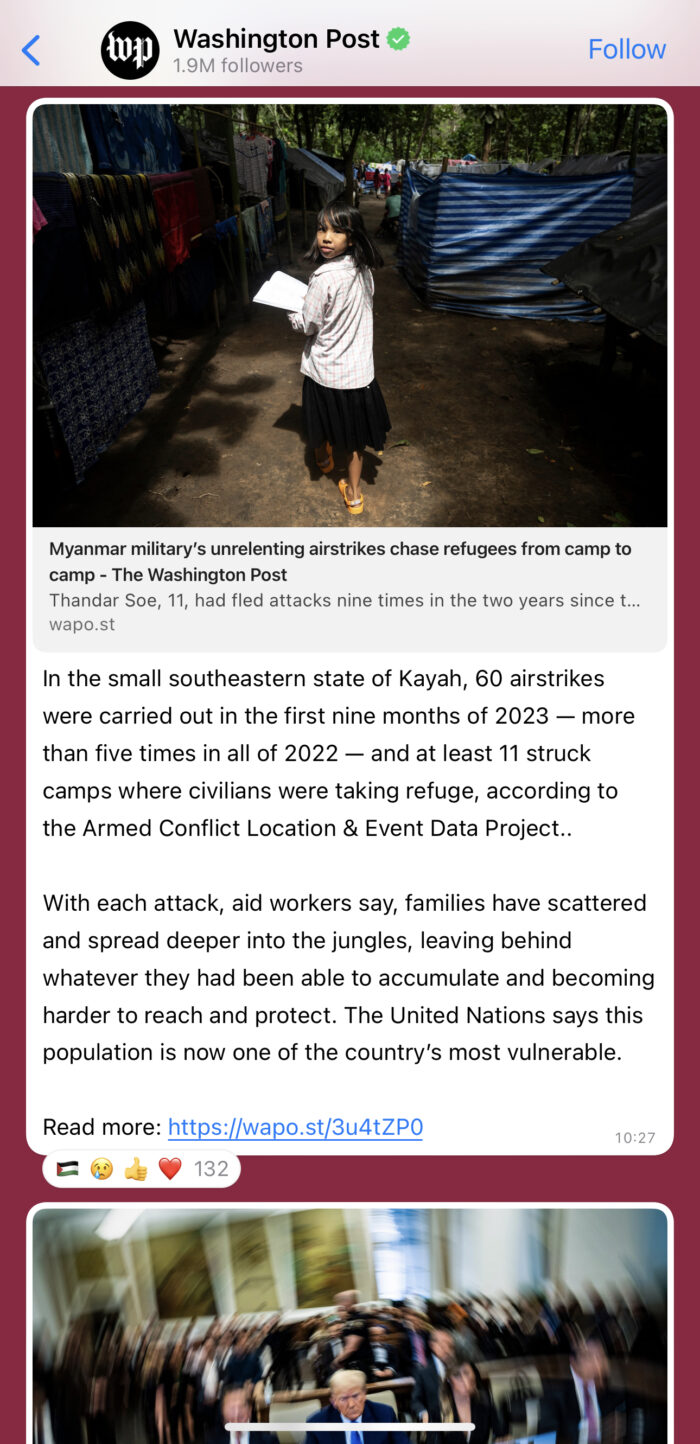
We’re only able to have one admin on the channel so currently, Travis Lyles, deputy director of social, posts everything. Travis and I confer on a daily basis about what’s good to post in the space. Any design or video elements are repurposed from our other social channels. We worked with our analytics team to set up specific tracking on stories we post on Channels.
The Israel-Hamas war has been a clear fit for the WhatsApp audience, mirroring interest at the beginning of the Ukraine war. We’ve also been sharing our FAQ-formatted articles for international coverage because we’ve seen increased audience interest in knowing the basics of what’s happening before just jumping into the nitty gritty.
We have been experimenting with text lengths, and so far, it’s hard to tell: longer messages get more engagement but shorter messages get more clickthrough. Overall, we just want to serve the audience as best we can and tailor each message so it’s best suited for them.
The Atlantic
Channel followers: 2,191,000
Common emoji reactions: 👍🇵🇸 🇮🇱 ❤️ 😮
Bhumika Tharoor, managing editor:
We recognize that we’re heading into a hugely consequential election in a moment when some social platforms have chosen to mute news, effectively making it harder to access reported, credible journalism. We take seriously our mission to spread truth and light in the world (with heaps of wonder and whimsy), and want to make it easier for readers to discover our stories.
We’ve been experimenting with different lengths of promotional copy and also with videos. Videos underperform compared to text/story links, and there’s no identifiable pattern yet around the length of promotional copy. We haven’t seen too much variation based on posting times, and the current understanding is that this audience is U.S.-based.

Our recent coverage of the Israel-Hamas war has generated a lot of interest. Stories about domestic politics and human nature tend to do well also. Click-throughs and reactions do turn out differently; there tend to be more reactions than clicks.
All reactions are restricted to emojis, as opposed to other platforms where people may comment or share, and have a broader range of expression. It’s an interesting approach: there are no bios or personalities on the channels, just a feed of stories paired with emojis and reaction sums. I suspect limiting responses to emoji reactions reduces the vitriol that can quickly spread on social media, though I wonder whether people are feeling like they can meaningfully engage with the stories on the platform.
We do wonder how people interpret the emojis they’re using: do they confuse the laughing to tears emoji with a sad crying one? Does it matter? We also have no access to audience demographics yet, but hope we’ll understand more about the channel soon.
Polygon
Channel followers: 836,400
Common emoji reactions: 😂 ❤️ 👍😮 🙏
Editor-in-chief Chris Plante and managing editor for audience insights Sadie Gennis:
With the collapse of Twitter, we’re living in a social media landrush. This is an exciting, albeit chaotic, opportunity for us to experiment with other platforms and gradually discover what makes sense for our audience. [But] there’s no guarantee it will survive the next year or two, and even if it does last, its audience will almost certainly be smaller than the dominant social media platforms of the past.
Communicating on What’sApp is effectively communicating through text messages, so we try to make the experience akin to getting occasional updates from a friend. The result, somewhat intentionally, feels like micro-blogs — little missives on the stuff we love to watch, play, and read that live alongside news and short grabby notes that would fit comfortably on Twitter/X.
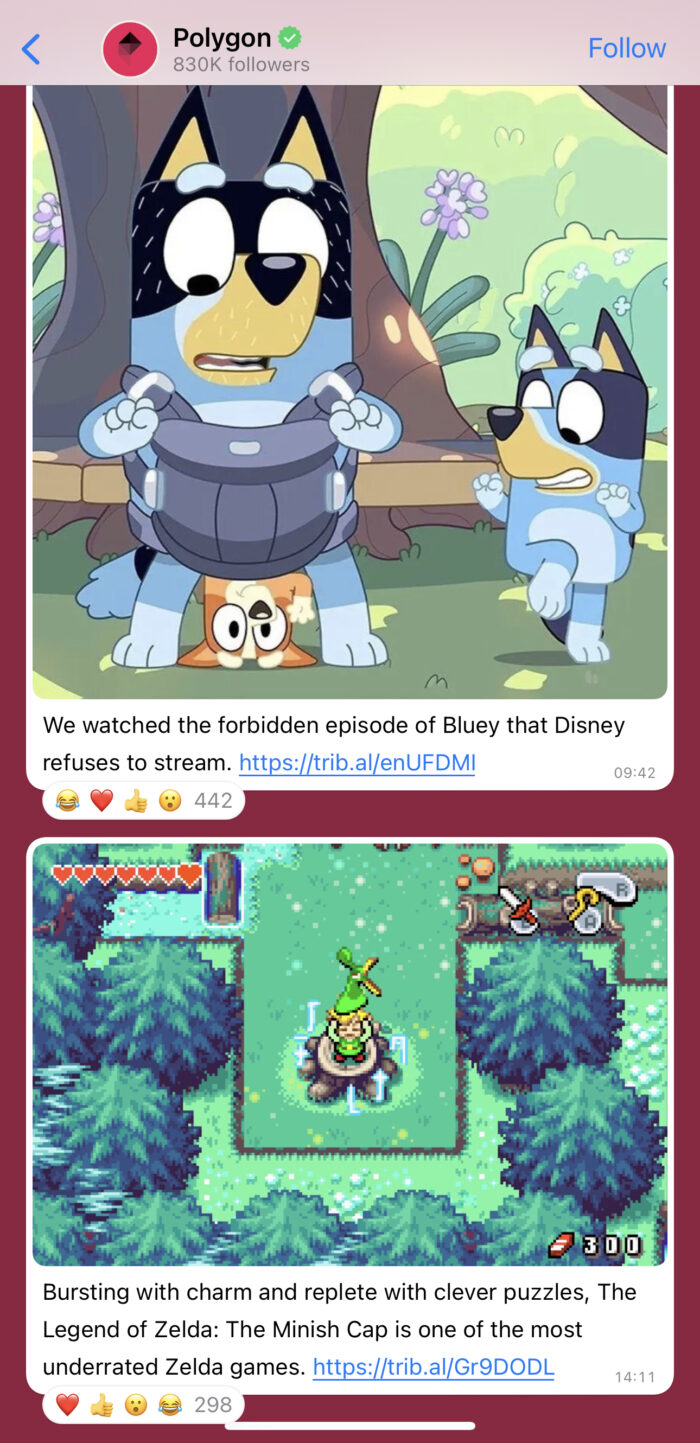
We’ve experimented with different lengths of texts, as well as link posts, posts with images, and video posts. At this time, there aren’t clear patterns for what does or doesn’t perform better in terms of engagement or clicks.
Factchequeado
Channel followers: 2,400
Common emoji reactions: 👍 😮 ❤️
Cofounders Laura Zommer and Clara Jiménez Cruz and editor-in-chief Tamoa Calzadilla:
The most viral stories [get the most clicks and reactions]. For example, we debunked a video (made as satire) that affirmed Selena Quintaniilla was still alive and another story stating that you needed to turn your cell phone off at night to avoid radiation. This lie had a particularly high level of engagement that has sustained itself for several months, as we strive to fight its circulation.
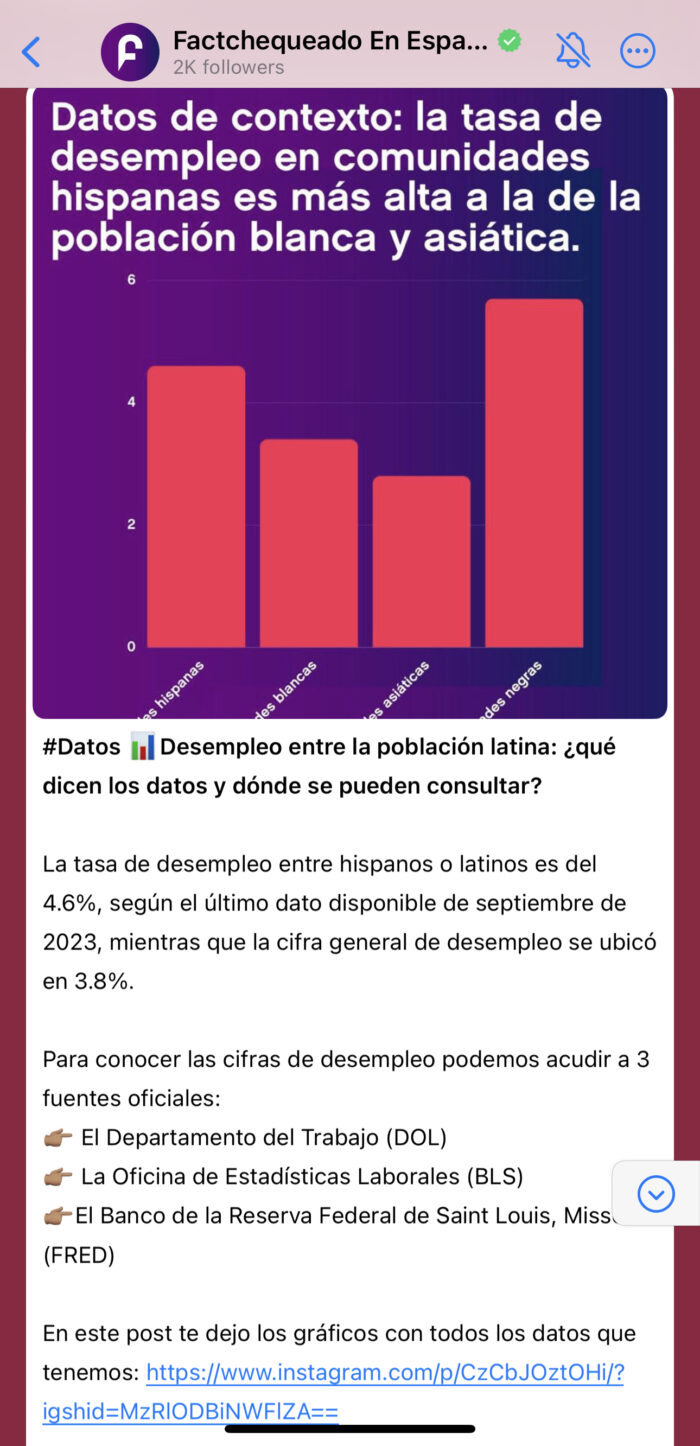 [We speak to our audience] as equals or peers, because somehow we are. Giving them tools to fight disinformation, demystifying urban myths, as well as alerting them about possible scams aimed specifically at [immigrants] to the United States. Sending them exclusive content through a one-way channel that allows them to forward it on to their families and friends without having to access any other platform. They have the fact-checked piece in their daily messaging system, easily on hand to share.
[We speak to our audience] as equals or peers, because somehow we are. Giving them tools to fight disinformation, demystifying urban myths, as well as alerting them about possible scams aimed specifically at [immigrants] to the United States. Sending them exclusive content through a one-way channel that allows them to forward it on to their families and friends without having to access any other platform. They have the fact-checked piece in their daily messaging system, easily on hand to share.
Unlike other networks, Channels is a unilateral, one-way communications system. This means that your access to your audience is somehow focused on a specific niche. As an organization, you can take advantage of a closer relationship with your contacts, which comes from you being the only one sending them messages in that specific space. You can create a sense of exclusivity and “intimacy” with your audience, which is a powerful and useful aspect to take advantage of.
Univision Noticias
Channel followers: 328,100
Common emoji reactions: 😮 🙏 👍 ❤️
Carolina Astuya, senior social media manager, and Juan Pablo Vargas, social media editor:
One person in our social team shares diverse content, from links to videos. Then we reviewed the numbers and added new content based on what our audience wanted to read. Our strategy seeks to share the most important content published daily on our website and on our social media platforms.

The stories with the highest performance on our WhatsApp channels directly affect our community in the United States, such as issues related to immigration. Likewise, other topics that also generate interest are human stories and breaking news. We see some news focused on particular cases has more significant interaction than general news, so our work also consists of giving greater depth to the facts and their implications.
To effectively engage readers from the start, it’s important to be specific in our headlines and prioritize key words at the beginning of the text, ensuring that the entire message captures their attention at first glance.
The Times of India (India)
Channel followers: 7,362,000
Common emoji reactions: 😢 👍 ❤️ 🇮🇳 🇵🇸 😂
Prasad Sanyal, business head of TOI’s parent company Times Internet:
Engagement is measured on the basis of reactions on the platform. The response is story based and not length based. We have experimented with long vs. short versions of the same news but the response does not differ. It is the gravity of the news which defines the response.

Certain genres work better than others: Topics of national interest like sports, science, and tech, and topics of personal benefit — like Vitamin D benefits, heart health stories, fitness stories, big-ticket entertainment events.
WhatsApp also is an opportunity to create communities where a niche audience can be tapped, and that’s one of the things that Times of India is exploring. We plan to connect with women audiences, parents, and more.
Posts usually after 7 p.m. do not work much, but the last post of the day gets the maximum response, so we send out any performance-driven posts as the last post — for example, app download pushes or TOI+ pushes.
Chilango (Mexico)
Channel followers: 14,900
Common emoji reactions: 👍 ❤️ 😂
Mael Vallejo, vice president of Chilango’s parent company Capital Digital:
It is an ideal medium to get closer to your audience and generate engagement, but it is not an easy channel for users to use. Many people are still unaware of it and are not familiar with it, so you have to guide them a little so that they learn where to find us and become familiar to it.
In general, we send short messages and it works for us to send GIFs or funny images. They are the ones that have the most reactions. We have experimented with sending various messages throughout the day and trying to take care of our tone by making it more casual, as if it were a friend sending you messages and not a company.

CNN en Español
Channel followers: 2,142,000
Common emoji reactions: ❤️ 😂 😢 👍
Esteban Campanela, executive producer of multi-platform content:
WhatsApp is unlike other platforms in that it is not necessary to post a high volume of content to avoid the perception of spamming your audience. We also think it’s important to encourage users to turn on notifications so they don’t miss any content.
In general, we believe media organizations will be more successful if they have a clarity on their main objective for this platform — whether it’s growing a loyal audience on WhatsApp Channels or if it’s to generate traffic to their websites — as that will inform the kind of content shared, and how it’s presented and adapted.
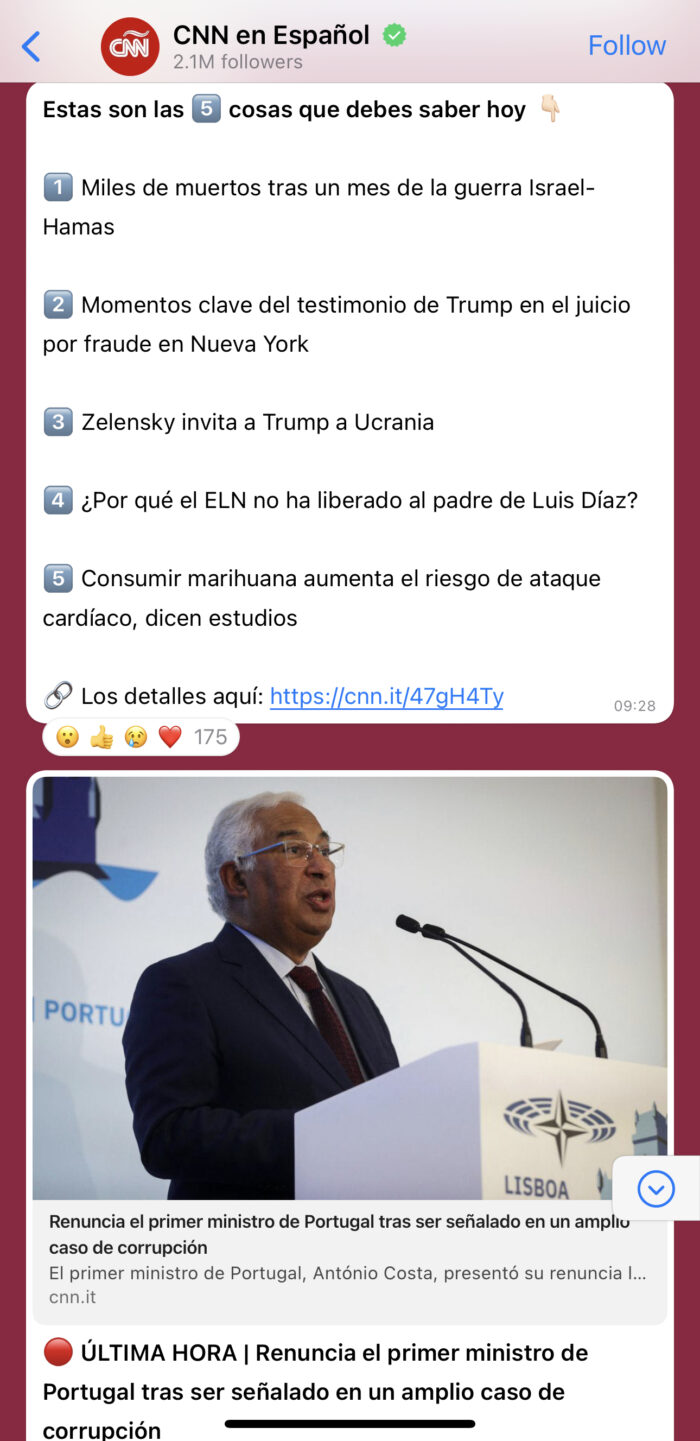
Axios
Channel followers: 546,800
Common emoji reactions: ❤️ 😂 🇵🇸 👍
Priyanka Vora, director of audience:
Our WhatsApp content is managed by audience editors who carefully curate stories and craft compelling copy tailored to our WhatsApp community. We are committed to respecting our readers’ time by avoiding overwhelming them with frequent news updates. To maintain quality, we uphold a high standard for the stories we share: in our local channels, we share just one story per day, and in our national channel, we share two.
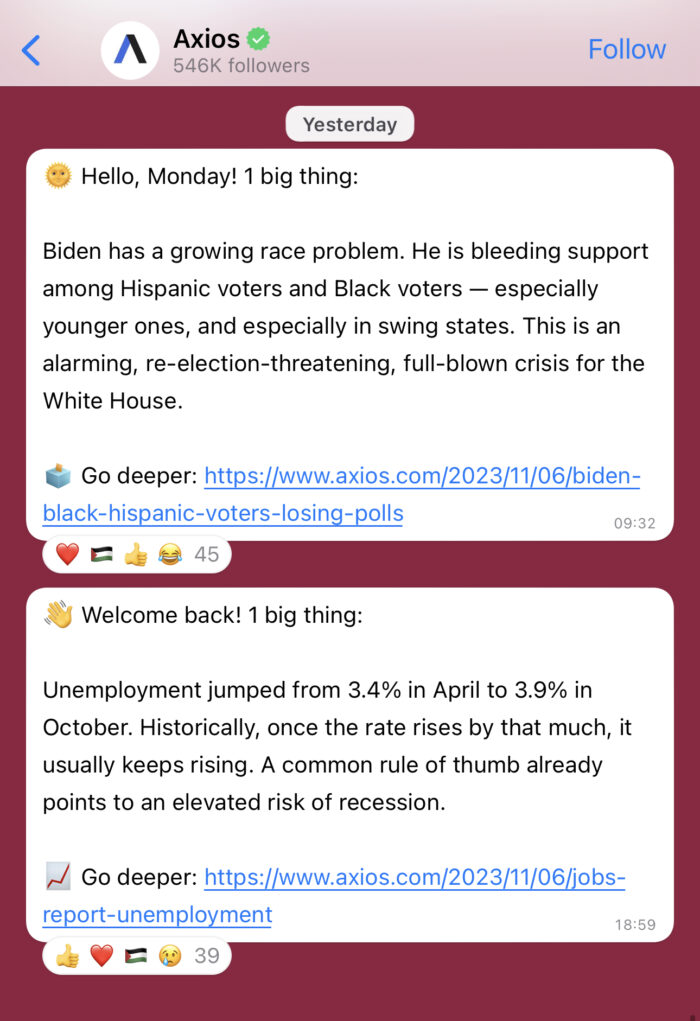
Currently, we are monitoring the growth of our channel’s followers, and we plan to implement promotions for Axios newsletters to better track conversions in the future. At present, our primary focus for WhatsApp is to create awareness rather than using it as a primary source of web traffic.
We are using Smart Brevity to inform our content strategy on WhatsApp with an emphasis on respecting our readers’ time by informing them of the “1 big thing” they need to know and giving them the choice to “Go Deeper.” Our aim is to meet the readers where they are and deliver news in the format that works best for that platform. We want our WhatsApp messaging to be “forward-worthy.”

















